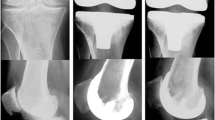Summary
This article reports on 207 implantations of the Blauth hinged endoprosthesis of the knee joint. Follow-up was possible in 188 (91%) of the implanted cases. The results could be clearly evaluated with a comparison between the time before and after operation, by means of a four-point system. They were very good in 85% and good in 11% of the cases, with an average follow-up period of 33 months, maximum longer than 8 years. The rheumatoid patients showed somewhat better results than those with osteoarthrosis. One of the main features of the success of the implanation in our follow-up patients was the relief from pain. To date, neither aseptic loosening nor fracture of prosthesis has been observed. The follow-up results, based on clinical aspects and constructional characteristics of the model during an observation period as long as 8 years, were encouraging. There was convincing evidence that because of the efficiency and predominance of the Blauth endoprosthesis no modification of the model was needed for further implantations. Technical complications could be prevented by careful manipulation. However, infection was still the most serious complication, affecting predominantly rheumatoid arthritis patients [6]. It always caused troublesome problems in management and jeopardized the success of the arthroplasty. The patella syndrome was another postoperative problem, though it was less serious than infection.
Zusammenfassung
Mit dieser Arbeit stellen wir 207 Kniegelenkendoprothesenfälle, Modell Blauth, vor. Die Resultate wurden verständlich bewertet durch unser Vier-Punkte-Bewertungssystem. Der durchschnittliche Zeitraum der Nachuntersuchung beträgt 33 Monate, der längste mehr als 8 Jahre. Es wurden 188 implantierte Kniegelenke nachuntersucht, das entspricht 91% der Gesamtserie. Das in 96% ermittelte gute Ergebnis schlüsselt sich auf in 21(11%) sehr gute und 158 (85%) gute Fälle. Nach der Implantation zeigten die rheumatoiden Patienten etwas bessere Resultate als die Patienten mit Gonarthrose. Das hervorstechendste Merkmal dieser Untersuchung stellt die Schmerzlinderung dar. In keinem Fall ist es bisher zu einer aseptischen Endoprothesenlockerung bzw. zu einem Prothesenbruch gekommen. Dies bedeutet, daß die Endoprothese in ihrem technischen „Design” allen dynamischen Kräften gewachsen ist, die bei der Belastung der Endoprothese auftreten. Dieses erfreuliche Ergebnis läßt klar erkennen, daß das von Blauth entwickelte Scharnierendoprothesenmodell unter Ausnutzung aller technischen Möglichkeiten der Implantation einen hervorragenden Platz in der Alloarthroplastik des Kniegelenks einnimmt. Zur weiteren Verwendung braucht das Modell keine Modifizierungen. Bei einem sorgfältigen Endoprotheseneinbau lassen sich technische Komplikationen weitgehend vermeiden. Die größte Gefahr droht durch die Infektion, die wir überwiegend bei Patienten mit chronischer Polyarthritis beobachtet haben und die uns therapeutisch vor schwierige Probleme stellen, die trotz adäquater Therapie meistens mit einem Mißerfolg enden [6]. Ein weiteres Problem stellt das sogenannte Patella-Syndrom dar, das das Gesamtergebnis, jedoch viel weniger schmälert als die Infektion.
Similar content being viewed by others
References
Aichroth P (1978) A knee function assessment chart. J Bone Joint Surg [Br] 60:308
Blauth W (1974) Über eine neue Kniegelenk-Totalprothese Med Orthop Techn 94:65
Blauth W, Hiss E, Jäger R (1980) Die Kniegelenktotalprothese nach Blauth. Med Orthop Techn 100:134
Cameron H (1982) The patella in total knee arthroplasty. Clin Orthop 165:197
Henche HR (1981) The areas of contact pressure in the patella-femoral joint. Int Orthop 4:279
König G (1981) Spätkomplikationen bei Knieendoprothesen und ihre Therapie bei Rheumatikern. Aktuelle Probleme in Chirurgie und Orthopädie, Bd 15. Huber, Bern Stuttgart Wien
Author information
Authors and Affiliations
Additional information
Based on author's dissertation “Blauth's Hinged Total Endoprosthesis of the Knee Joint” directed by Prof. Dr. G. König.
Rights and permissions
About this article
Cite this article
Wang, WN. Clinical observations on blauth's total endoprosthesis of the knee joint. Arch Orthop Trauma Surg 103, 263–268 (1984). https://doi.org/10.1007/BF00387332
Received:
Issue Date:
DOI: https://doi.org/10.1007/BF00387332




